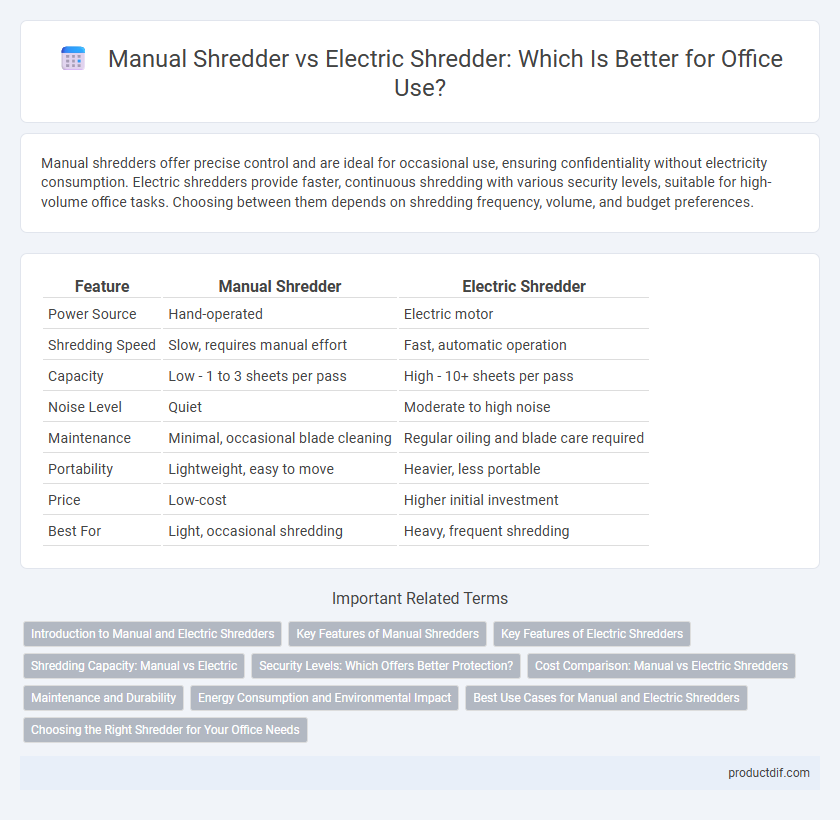Manual shredders offer precise control and are ideal for occasional use, ensuring confidentiality without electricity consumption. Electric shredders provide faster, continuous shredding with various security levels, suitable for high-volume office tasks. Choosing between them depends on shredding frequency, volume, and budget preferences.
Table of Comparison
| Feature | Manual Shredder | Electric Shredder |
|---|---|---|
| Power Source | Hand-operated | Electric motor |
| Shredding Speed | Slow, requires manual effort | Fast, automatic operation |
| Capacity | Low - 1 to 3 sheets per pass | High - 10+ sheets per pass |
| Noise Level | Quiet | Moderate to high noise |
| Maintenance | Minimal, occasional blade cleaning | Regular oiling and blade care required |
| Portability | Lightweight, easy to move | Heavier, less portable |
| Price | Low-cost | Higher initial investment |
| Best For | Light, occasional shredding | Heavy, frequent shredding |
Introduction to Manual and Electric Shredders
Manual shredders operate without electricity, relying on hand-cranking to cut paper into strips or confetti, making them ideal for small-scale or infrequent shredding tasks. Electric shredders use motorized mechanisms to quickly and efficiently destroy larger volumes of documents with varying security levels, suitable for office environments requiring frequent use. Both types offer distinct benefits in terms of speed, convenience, and maintenance depending on the shredding needs of a workspace.
Key Features of Manual Shredders
Manual shredders offer precise control over the shredding process with their hand-operated mechanisms, making them ideal for light-duty office tasks. They require no electricity, providing energy efficiency and quiet operation in any workspace. Compact and portable designs make manual shredders suitable for small offices or personal use where occasional document destruction is needed.
Key Features of Electric Shredders
Electric shredders typically feature high-speed motorized blades capable of shredding large volumes of paper quickly and efficiently, making them ideal for busy office environments. They often include advanced safety features such as automatic shut-off when hands or foreign objects are detected, and can handle a variety of materials including credit cards, CDs, and staples. Many models offer continuous operation with thermal protection to prevent overheating, along with larger waste bins to reduce the frequency of emptying.
Shredding Capacity: Manual vs Electric
Manual shredders typically handle up to 3-5 sheets per pass, making them suitable for low-volume shredding tasks. Electric shredders can process anywhere from 8 to 30 sheets simultaneously, significantly increasing efficiency for high-volume office environments. High-capacity electric shredders often feature continuous run times and larger waste bins, enhancing productivity and convenience.
Security Levels: Which Offers Better Protection?
Manual shredders typically provide lower security levels, suitable for basic document disposal with strip-cut or cross-cut options, while electric shredders often feature advanced shredding types like micro-cut or nano-cut that significantly enhance protection against identity theft. Electric shredders operate at higher speeds and can handle larger volumes, making them ideal for businesses requiring stringent security standards compliant with regulations such as HIPAA or FACTA. Choosing the right shredder depends on the sensitivity of the information and the required security level to prevent unauthorized data retrieval.
Cost Comparison: Manual vs Electric Shredders
Manual shredders offer a low-cost option ideal for light, occasional use, with initial prices typically ranging from $10 to $50. Electric shredders have a higher upfront cost, usually between $50 and $300, but provide faster, more efficient shredding suitable for regular, heavy-duty tasks. When considering long-term expenses, electric models may incur higher electricity consumption, while manual shredders have negligible operating costs but require increased physical effort.
Maintenance and Durability
Manual shredders require minimal maintenance, often limited to occasional blade oiling and careful handling to prevent wear, making them suitable for low-volume shredding tasks. Electric shredders need regular maintenance such as blade cleaning, oiling, and occasional motor inspection to ensure longevity, especially in high-volume office environments. Electric models typically offer greater durability and consistent performance under heavy use, whereas manual shredders may experience quicker blade dulling with frequent operation.
Energy Consumption and Environmental Impact
Manual shredders consume zero electricity, making them highly energy-efficient and ideal for eco-conscious offices aiming to reduce carbon footprints. Electric shredders require a continuous power supply, leading to higher energy consumption and potential environmental concerns unless powered by renewable energy sources. Choosing manual shredders minimizes hazardous e-waste and contributes to sustainable office practices by reducing reliance on fossil fuels.
Best Use Cases for Manual and Electric Shredders
Manual shredders are best suited for light-duty tasks such as shredding a few sheets of paper occasionally, ideal for home offices or environments with low-volume shredding needs. Electric shredders efficiently handle larger volumes of paper and various materials like credit cards or CDs, making them perfect for busy offices requiring frequent, high-capacity shredding. Choosing between manual and electric shredders depends on shredding frequency, volume, and the types of materials to be destroyed.
Choosing the Right Shredder for Your Office Needs
Manual shredders offer cost-effective, low-volume paper destruction ideal for small offices with minimal shredding requirements, while electric shredders provide high-speed, automatic shredding suitable for larger offices handling significant document disposal. Consider factors such as shredding capacity, security level (cross-cut, micro-cut), noise level, maintenance needs, and budget constraints when choosing the right shredder for your office. Prioritizing a shredder that balances efficiency and compliance with data protection regulations ensures optimal operational productivity and information security.
Manual Shredder vs Electric Shredder Infographic

 productdif.com
productdif.com